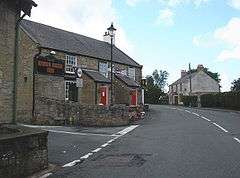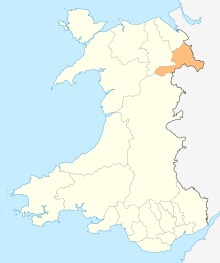Bwlchgwyn
Bwlchgwyn is a village in Wrexham county borough, Wales, on the A525 road, 5 miles (8 km) west of the town of Wrexham and 10 miles (16 km) south-east of the town of Ruthin. Bwlchgwyn is part of the community of Brymbo. In the 2011 Census the population of the village was 855.[1]
| Bwlchgwyn | |
|---|---|
 Pub on the A525 road through Bwlchgwyn | |
 Bwlchgwyn Location within Wrexham | |
| Population | 855 (2011) |
| OS grid reference | SJ264533 |
| Community | |
| Principal area |
|
| Ceremonial county | |
| Country | Wales |
| Sovereign state | United Kingdom |
| Post town | WREXHAM |
| Postcode district | LL11 |
| Dialling code | 01978 |
| Police | North Wales |
| Fire | North Wales |
| Ambulance | Welsh |
| UK Parliament | |
| Senedd Cymru – Welsh Parliament |
|
Etymology
The placename Bwlchgwyn has in the past been translated into English as "White Pass", perhaps referring to the white limestone cliffs in the area. It has also been suggested that the original name was Bwlchgwynt meaning "wind pass". The translation "pass", however, does not entirely fit with the Welsh word bwlch and its usual usage in placenames. Meaning hollow, dip, gap, aperture or notch, when bwlch is used elsewhere in Wales, it is used as a prefix in a word describing a steep ravine. Other examples are Bwlch-y-Saethau, Bwlch Tryfan, Bwlch Main and Bwlch Eryl Farchog. All are characterised by very steep-sided ravines. Bwlchgwyn has at its edge the deep-sided ravine of Nant-y-Ffrith, a prominent geographical feature.
The gwyn in Bwlchgwyn, meaning "white", is thought to point to the area being the first and last place in the district where snow settles. Similarly, nearby Gwynfryn means "white hill".
The young organisers of the Bwlchgwyn Eisteddfod in 1903 referred to themselves as "'Gwyr Ieuainc y Bwlch" (the young men of the ravine), proudly associating themselves with this prominent feature.[2]
Geography
At a height of 1,090 feet (333 m) above sea level, it claimed to be the highest village in Wales until December 2015, when it was discovered that Trefil in Blaenau Gwent is actually the highest by the Ordnance Survey.[3] As such, the village will now be removing the signs claiming to be the highest village.[4] As the village is so high, there is a good view of the Peak district, Frodsham Hill and the Cheshire Plain; with Jodrell Bank being seen on clear days.
Two rivers have their sources near the village: the River Gwenfro rises on the south side of the village and the Nant-y-Ffrith flows through a wooded valley to the north.
The village is built on Cefn-y-fedw sandstone, a type of Millstone Grit from the Carboniferous period. It contains veins of lead ore and various other minerals.
History
Bwlchgwyn has been inhabited since at least the Bronze Age when a hill fort was built there (now destroyed by quarrying). It is thought that the original Brythonic inhabitants and later the Romans worked the shallow lead veins of the Eisteddfod, with the small fort possibly being a base for these operations. It has been suggested (by Ivan Margary, pioneering historian of Roman roads) that the old road up from Glascoed and along the ridge above Nant-y-Ffrith is of Roman origin: followed, from Bwlchgwyn, by today’s main road, it runs to the hamlet near Landegla called Pen-y-stryt (“the end of the road“) and then across the moors. Ancient hedgerows, dating from this period can also be found opposite George Edwards and son bus depot.
Until the 19th century the area was common land used for grazing with only a few houses. As with other villages in this area, such as Coedpoeth, Gwynfryn and Minera, the village prospered in the agricultural and industrial revolutions, benefiting from the rich deposit of silica underground. Local quarries and coal mines provided employment, and the village grew. The nearby Minera Limeworks was the largest employer in the area until it closed in the 1970s. In 1954 the Bwlchgwyn Silica Company even proposed to purchase the entire land of Bwlchgwyn for mining purposes and force residents to move. This plan was accepted, but after campaigns by local villagers and a councillor, Mr. Hooker, it was eventually denied and the company soon ceased to operate.
Several public houses opened in the area, one of which still remains - The King's Head Inn, seen in the photograph above. Two chapels were built in the village: the Nebo Chapel was first built in 1852 and had a peak congregation of 150. Bwlchgwyn School opened in 1875; the building stood for over 100 years before being replaced by a new school. The Welsh-language author Edward Tegla Davies was a pupil and later a teacher there. A gothic hall was situated on the top of Fron Heulog hill in the late 19th and early 20th centuries; known as Fron Heulog Hall. At one time it was a hotel, much famed for the restorative properties of the clear air. It was later demolished due to quarry work nearby.
Bwlchgwyn today
Today the village has its own primary school, with secondary schooling in Wrexham. The bus company George Edwards and Son is based in Bwlchgwyn. It formerly operated the village bus service but now only runs coach trips. The main road through the village is the A525 between Newcastle-under-Lyme and Rhyl. This creates a high volume of traffic through the village, although this was calmed by road improvements to a parallel route going around the village.
There is a well-used community centre which is also home to the local toddler group, an indoor bowls club, WI, Craft Club, Scouts and Beavers. The community centre can be found inside the park, with outside play area with climbing frames and also includes two tennis courts which can be freely accessed by the public.
Recently, a Motor safari has been developed in the Silica quarry in Bwlchgwyn. Notably, attendees include Top Gear.
References
- Office for National Statistics. "Census 2011 Usual resident population". Retrieved 2 July 2013.
- "Bwlchgwyn, Eisteddford Gadeiriol y Gwyr Ieuaingc – Gwyl y Bangciau". Baner ac Amserau Cymru (in Welsh). 12 August 1903. Retrieved 3 May 2020.
- Ordnance Survey. "MapZone". Retrieved 4 March 2007.
- The Telegraph. "Highest village in Wales' suffers fall from grace". Retrieved 24 December 2015.
- Gwenda Lewis (2005) I Remember... My Life in Bwlchgwyn 1939-1943.
External links
| Wikimedia Commons has media related to Bwlchgwyn. |
